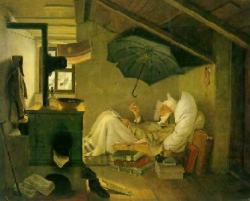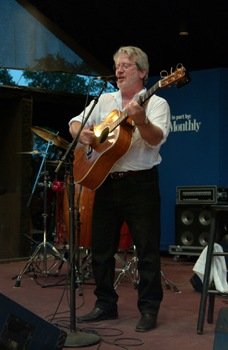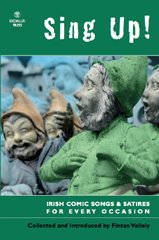
Vince Bell, One Man's Music - The Life and Times of Texas Songwriter Vince Bell. UNT Press, 2009, ISBN 978-1-57441-267-3, 261 pp, US-$ 14.95.
FolkWorld Issue 39 07/2009; Book Reviews by Walkin' T:-)M

Early on, I knocked the wind clear out of the guitar like an accordion when I fell belly-down on it, remembers Vince Bell. The phone rang while I was practicing a nervous-kneed but windy stance. While hurriedly climbing up a couple of stairs, I tripped with the guitar strapped around my neck. The sound was sickening as I fell flat on the instrument. I carefully rolled over like a grieving lover, sat up, and squeezed my eyes shut for a split second. In a shock when I opened them wide, I saw that the guitar's side and back had seven cracks. Seven cracks? Emergency lights and sirens whined in my head.
 Vince Bell, One Man's Music - The Life and Times of Texas Songwriter Vince Bell. UNT Press, 2009, ISBN 978-1-57441-267-3, 261 pp, US-$ 14.95. |
What happenend to his Martin guitar was just like a self-fulfilling prophecy. In December 1982 Vince Bell was broadsided by a drunk driver. He was thrown over 60 feet from his car, and suffered multiple lacerations to his liver, embedded glass, broken ribs, a mangled right forearm and a severe traumatic brain injury. Before that terrible accident, Vince Bell grew up in Houston's Old Quarter where he was able to see Townes Van Zandt and actually learned an A-minor chord from him (-> FW#34). Vince struggled to become a songwriter:
Only the musically inclined could find the cheapest gas known to man, the oldest car to put it in that would still make it to a gig, or the smallest apartment, trailer, or broken-down house to park beside, behind the tallest weeds on the block to hide your wheels from the car-thieving neighbors. You knew the bargain at every restaurant, discount store, and grocery for miles around.
 Vince Bell @ FolkWorld: FW #35 |
I was just getting to work, and a team of three or four staff members was running down the hall with a patient in a bed. The team was moving extremely fast, and I knew whatever was happening was really bad. I said I had seen him play music at a public radio fundraiser. They said they were going back to surgery to remove his right arm that had been severely damaged in the wreck. I just remember saying over and over, You can't cut his arm off, he's a musician. How will he survive all of this if he can't play his guitar?It saved his right arm, but Vince spent a month in a coma. Risen from the dead, it took years to relearn to do the simplest things: walk, talk, taste, fell arms and legs, much less play music and resume his career. So the middle section of his autobiography One Man’s Music, revised and expanded from the 1998 edition, is about his painful recovery. It is painful to read as well and makes you sometimes cry.
However, Vince wrote down no one can knock the song out of me. He taught himself one more time to fingerpick and sing with a paralyzed vocal chord. He started recording again, and his career gathered momentum when Nanci Griffith decided to record his "Sun & Moon & Stars" and Lyle Lovett his "I've Had Enough".
In 1993, Vince went into the studio again, this time with producer Bob Neuwirth, to record "Phoenix" to critical acclaim.
As we embarked on a song, Bob would gaze athmospherically through the double panes, a hand on his chin, or with arms folded. In a relaxed motion, he reached out and pressed a button on the massive studio console in the control room. Click ... (Pause). Vince, you sang that last one just like Caruso. (Pause) ... click. Thanks, Bob. I puffed up like a rookie in front of the distinguished musicians, whose eyes now wandered about the room. Click ... (Pause). But Vince (pause, and now a little more emphatically), you aren't Caruso. Just tell the story, OK? Try it again. (Pause) ... click.
|
The visual is as much a part of Irish traditional music as it is of life.
It is an essen-tial dimension of the full communi-cation that hap-pens between its performers and
audiences. Our experience of the music is incom-plete, we find, unless we can see it being made
as well as hearing it, and see also the effects it has on the people listening to it.
Irish photographer Tony Kearns has been specialising in taking pictures of Irish traditional musicians, singers and
dancers (just as Christy McNamara -> FW#34).
His playground became the Willie Clancy Summer School in Miltown Malbay, Co. Clare,
held in honour of the great uilleann piper Willie Clancy since 1973
(#36).
With writer Bary Taylor he already produced an illustrated history of the school in 2003.
Music & Light - Ceol & Solas contains 130 black & white photographs of musicians, singers and dancers
taken from 1992 to 2005 (see some selected pictures throughout this page),
both formal portraits as well as artists in full flight. He documents all aspects:
classes, sessions, recitals, céilís. Most are unfamilar faces (and this is what is all about actually),
but there are also musicians well-known to Irish music lovers worldwide, such as
pipers Martin Nolan (#24),
Kevin Rowsome (#21),
Ronan Browne (#21),
Paddy Keenan (#23),
Mick O'Brien (#27),
flutists Cathal McConnell (#32),
John Blake (#27),
fiddlers Oisin Mac Diarmada (#32),
Martin Hayes (#35),
Mick Conneely (#21),
Ben Lennon (#37),
James Kelly (#30),
Paul O'Shaughnessy (#31),
box players Joe Burke (#34),
Bobby Gardiner (#7),
Brendan Begley (#23),
harmonica player Rick Epping (#37),
singers Helen Roche (#31),
Niamh Parsons (#34), ...
These pictures don't rob the musician's soul, in contrary, they add something essential.
P.S.: Besides the book you can order quality A4 prints from Tony's website.
Tony Kearns, Music & Light - Irish Traditional Music Photography.
Silver Spear Press, 2008, ISBN 978-0-9560492-0-9, 160pp, €20.
Tony Kearns & Barry Taylor, A Touchstone for the Tradition - The Willie Clancy Summer School.
Brandon Press,
2003, ISBN 978-0-863223-0-82.
|
T-Bone Burnett wrote in the liner notes: Just past Joshua Tree there's a bumper sticker on a bent up '74 Dodge pickup that claims Jesus will be back soon. I hope that's true. But in the meantime, happily, Vince Bell is back now.
This survivor who made the road to hell and back has something to tell. Beat up guitars have more stories. And there's more stories as there are pages in this book. His writing is colourful and sometimes witty and ironic: coffee and marijuana: drug maintenance and the first two things you needed to start a rock'n'roll band , even ahead of a new set of strings...
Vince Bell is currently working on a theatrical production based on the book, a filmed version, and a CD featuring his best songs has been released at the same time as the book. Songs from which his old buddy Hobart Taylor says: Vince is an individual before a style. Vince's songs are not folk songs, they are art songs. And they are closer to Jacques Brel than Woody Guthrie.
 Fintan Vallely, Sing Up! - Irish Comic Songs and Satires for Every Occasion.
Dedalus Press,
2008, ISBN 978-1904556978, 254 pp, €25.
|
|
Oh come all ye pleasant fellow peasants and listen to my song; It has but twenty verses, even if it seems three times as long. |
Vince Bell always has been a serious songwriter. However, way back in the 1970s he used to perform a stand-up comedy-music show, since the comedy part of a one-man, one-guitar show could save your dusty butt in the least amusing places, like a tacky Central Texas fern bar for trendy chicks in a shopping mall next to a department store near an army base.
There is nothing wrong with comedy and comical songs. Sing Up! - Irish Comic Songs and Satires for Every Occasion is a gather-up of intolerance, irreverence, slagging and sedition, compiled by Fintan Vallely. Fintan is a traditional musician as well as a writer on traditional music, e.g. "The Companion to Irish Traditional Music (1999, revised edition in due time) and "Tuned Out: Protestant Attitudes to Traditional Music in Northern Ireland" (2008 -> FW#38).
There are songs about Irish politics, religion, sports and music, such as an Arab Orange Lodge, Dunne(s) Stor(i)es or the Moving Statues Movement. Most of the grotesque, unbelievable, bizarre and unprecedented events took place in the 1980s and 1990s, the verses however are in the style of 19th century balladry.
Fintan (with Tim Lyons) already recorded a couple of these songs under the disguise of "Scithereedee - Big Guns & Hairy Drums" in 2000. The book features 76 songs from Vallely, Lyons and 22 other authors. Almost all are male, and Fintan muses that the tendency has been for females to be less concerned on the humour front, and more getting serious things said (or maybe the Y-front of the species uses humour to avoid thinking too deeply?)
There are 19th century poets John Shiel and Darby Ryan ("The Peeler and the Goat"), and eventually Adam McNaughton's "Oor Hamlet," the Prince of Denmark's story in half a dozen verses to the air of "Mason's Apron," which Scottish singer Iain Mackintosh used to sing (-> FW#15).
Some of these songs will appeal to an international audience. For example, there is Crawford Howard's parody on Eric Bogle's (-> FW#31) WW1 song "Willie Mac Bride":
|
Have you heard of the song about Willie Mac Bride? If I hear it again it'll turn me inside. For it's sung in the Springtime, it's sung in the Fall, And mostly be people who can't sing at all. Oh, Willie Mac Bride why the hell did you die? The trouble you'd have saved if you'd come back alive. If you'd got a good job, or signed on the b'roo - We'd not have to listen to songs about you. But still I don't know now - I'm glad that you're dead With the green Fields of France piled up over your head; For the trouble you've caused since the day that you died Oh, shootin's too good for you, Willie Mac Bride. |
 Another Bogle song, "The Band Played Waltzing Mathilda," is ridiculed by Sheila Miller:
Another Bogle song, "The Band Played Waltzing Mathilda," is ridiculed by Sheila Miller:
|
How well I remember when I first heard that song, Realised I was on to a good thing. It could bring fame and fortune, I cared not a whit That I hadn't the voice for to song it. We all jumped up on the bandwagon; And we massacred 'Waltzing Matilda' With our banjos, keyboards and guitars. Oh, we were the first, but in time others came And we all had a hand in the slaughter, The tuneless, the tasteless, the drunk, the insane And not one asked the leave of the author. So we all sang 'Waltzing Matilda', And we wrangled and bickered and brawled, Till breath by breath, we just sang it to death And now nobody sings it at all. |
 The bodhran, the Irish frame drum (-> FW#36),
and its devotees are subject of several songs:
The bodhran, the Irish frame drum (-> FW#36),
and its devotees are subject of several songs:
During the Revival throughout the sixties and seventies there was a mad stampede to get doing something musical. Many of these were inncocent dabblers, and would sometimes take up the tin whistle. That was often considered to have no sex appeal and too hard, so more commonly they would take up the bodhrán. This infatuation with simplicity is also one of the curious facts to emerge from observation of the music-loving species of foreign tourists in Ireland. Some say that the primitive thump could be felt to mimic the pounding machinery of the Teutonic work-ethic. Worse still, it has made the life of an Irish goat about as relaxed as Salman Rushdie's. Several hundred goats per annum give their lives in pursuit of the bodhran fashion, and tonnes of the devices are played by otherwise vegetarians.
|
I'm a new-age vegetarian, Greenpeace-y sort of chap; I save my whales and, as a male, I don't indulge in sexiest crap; But I'll confess that I've a failing that I can't control, I find I need percussion's healing beat to regulate my mind. And yes, I know it's con-tra-dict-ry - I'm exploiting a goat's hide - For leisure, when all other leather yokes I won't abide. |
 The bodhran story may be told from the point of view of the goat:
The bodhran story may be told from the point of view of the goat:
|
Now I'd have no objection if I'd choice in resurrection, I'd return as fiddle, flute or an accordion; For with my luck some tuneless shit, or mindless thumpin' German git, Will possess me if I end up as a bodhran. |
No notation is given, but some suitable airs mentioned,
for these songs are most effectively sung in the traditional style -
to a variety of metrically-suitable airs, unaccompanied, bendable and potentially response-generating.
|
To the German FolkWorld |
© The Mollis - Editors of FolkWorld; Published 07/2009
All material published in FolkWorld is © The Author via FolkWorld. Storage for private use is allowed and welcome. Reviews and extracts of up to 200 words may be freely quoted and reproduced, if source and author are acknowledged. For any other reproduction please ask the Editors for permission. Although any external links from FolkWorld are chosen with greatest care, FolkWorld and its editors do not take any responsibility for the content of the linked external websites.
